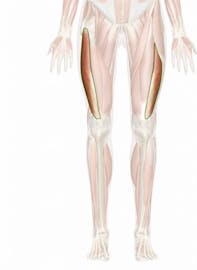Vastus Lateralis Muscle

The vastus lateralis muscle is the largest of the four muscles that make up the quadriceps femoris group. Like the other muscles in the quadriceps group, is an extensor of the leg at the knee. Its name means "huge lateral" due to its enormous size and location on the lateral side of the thigh.
Anatomy
The vastus lateralis muscle arises from widespread origins on the greater trochanter of the femur and on the linea aspera on the posterior side of the femur. From its origins, the muscle fibers of the vastus lateralis extend anteriorly and distally to merge with the other three muscles of the quadriceps, forming the quadriceps tendon. From this point, the quadriceps tendon continues distally to insert on the patella.
Histology
Like all skeletal muscles, the vastus lateralis is made of many skeletal muscle fibers (cells) surrounded by connective tissue. A layer of fibrous connective tissue known as the endomysium wraps each muscle fiber. Another layer of connective tissue known as the perimysium further wraps groups of muscle fibers, known as fascicles. Blood vessels and nerves pass through the spaces between fascicles to provide nutrients, oxygen, and nerve signals to the muscle fibers. All of the fascicles, vascular tissue, and nervous tissue in the muscle are wrapped up in the epimysium, which forms the outer layer of the muscle. At the ends of the muscle, the endomysium, perimysium, and epimysium continue beyond the ends of the muscle fibers to form the tendons that bind the vastus lateralis to the femur and patella.
Physiology
Contraction of the vastus lateralis draws the patella towards the anterior surface of the femur. The patellar ligament connects the patella to the tibial tuberosity on the anterior surface of the tibia, so that anterior movement of the patella also draws the tibia anteriorly. The net result of the contraction of the vastus lateralis is therefore extension of the leg at the knee.


